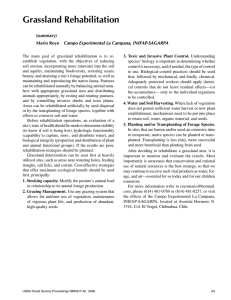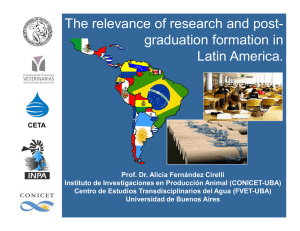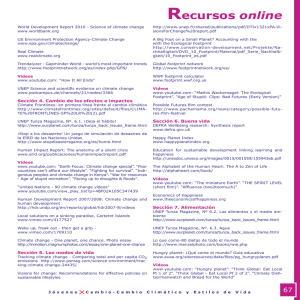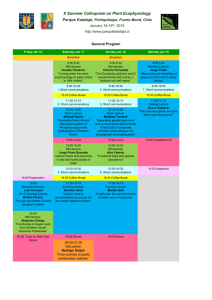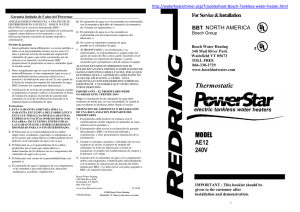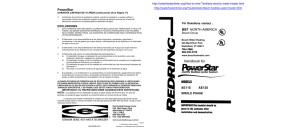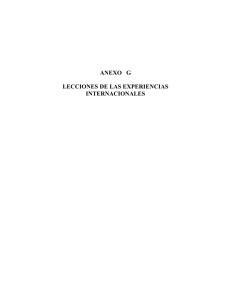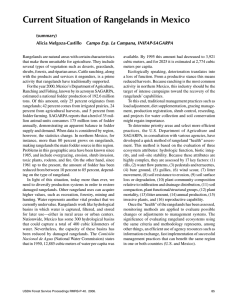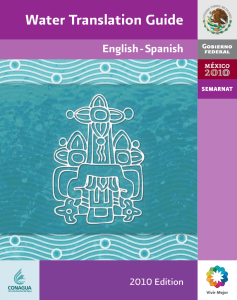Climate Change and SEA in Northern Chilean Andes1 Hugo
advertisement
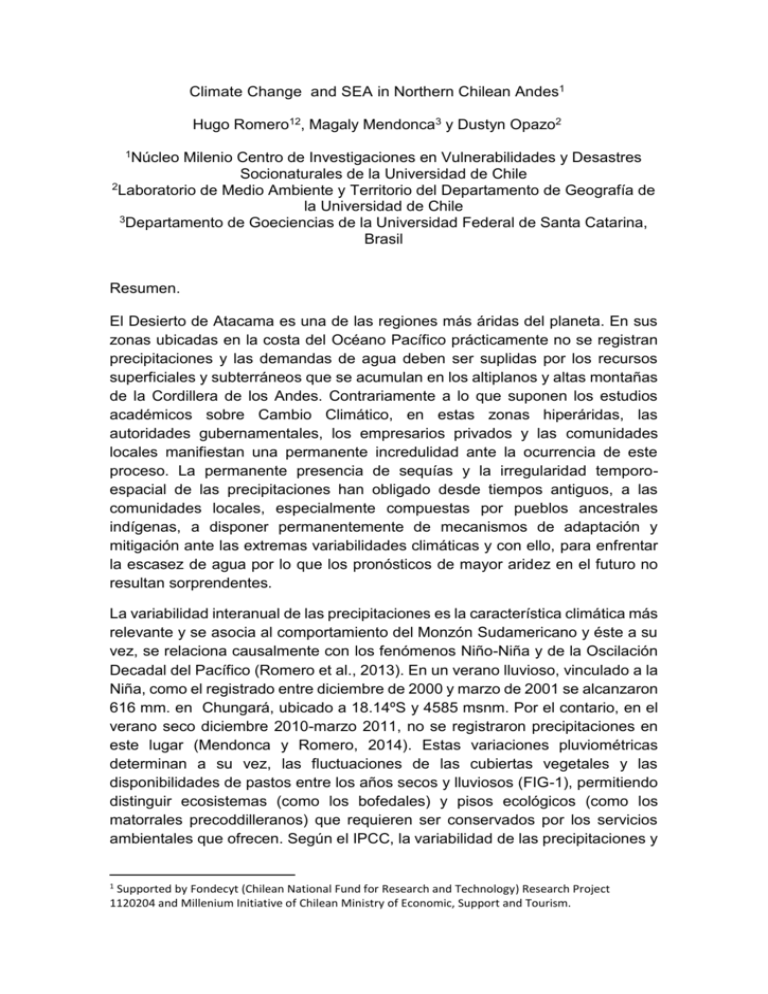
Climate Change and SEA in Northern Chilean Andes1 Hugo Romero12, Magaly Mendonca3 y Dustyn Opazo2 1Núcleo Milenio Centro de Investigaciones en Vulnerabilidades y Desastres Socionaturales de la Universidad de Chile 2Laboratorio de Medio Ambiente y Territorio del Departamento de Geografía de la Universidad de Chile 3Departamento de Goeciencias de la Universidad Federal de Santa Catarina, Brasil Resumen. El Desierto de Atacama es una de las regiones más áridas del planeta. En sus zonas ubicadas en la costa del Océano Pacífico prácticamente no se registran precipitaciones y las demandas de agua deben ser suplidas por los recursos superficiales y subterráneos que se acumulan en los altiplanos y altas montañas de la Cordillera de los Andes. Contrariamente a lo que suponen los estudios académicos sobre Cambio Climático, en estas zonas hiperáridas, las autoridades gubernamentales, los empresarios privados y las comunidades locales manifiestan una permanente incredulidad ante la ocurrencia de este proceso. La permanente presencia de sequías y la irregularidad temporoespacial de las precipitaciones han obligado desde tiempos antiguos, a las comunidades locales, especialmente compuestas por pueblos ancestrales indígenas, a disponer permanentemente de mecanismos de adaptación y mitigación ante las extremas variabilidades climáticas y con ello, para enfrentar la escasez de agua por lo que los pronósticos de mayor aridez en el futuro no resultan sorprendentes. La variabilidad interanual de las precipitaciones es la característica climática más relevante y se asocia al comportamiento del Monzón Sudamericano y éste a su vez, se relaciona causalmente con los fenómenos Niño-Niña y de la Oscilación Decadal del Pacífico (Romero et al., 2013). En un verano lluvioso, vinculado a la Niña, como el registrado entre diciembre de 2000 y marzo de 2001 se alcanzaron 616 mm. en Chungará, ubicado a 18.14ºS y 4585 msnm. Por el contario, en el verano seco diciembre 2010-marzo 2011, no se registraron precipitaciones en este lugar (Mendonca y Romero, 2014). Estas variaciones pluviométricas determinan a su vez, las fluctuaciones de las cubiertas vegetales y las disponibilidades de pastos entre los años secos y lluviosos (FIG-1), permitiendo distinguir ecosistemas (como los bofedales) y pisos ecológicos (como los matorrales precoddilleranos) que requieren ser conservados por los servicios ambientales que ofrecen. Según el IPCC, la variabilidad de las precipitaciones y 1 Supported by Fondecyt (Chilean National Fund for Research and Technology) Research Project 1120204 and Millenium Initiative of Chilean Ministry of Economic, Support and Tourism. la incertidumbre sobre la disponibilidad de agua aumentará en el futuro (Sarricolea, 2014), limitando la instalación de las actividades productivas en una región que concentra las inversiones mineras y sus servicios asociados (fig.2). Consecuentemente, la variabilidad y cambio climático deberían ser consideradas como principales restricciones para el desarrollo sustentable de las regiones del Norte de Chile y la mitigación y adaptación a este evento, uno de los principales objetivos a ser considerados en la EAE. En términos de efectos de la variabilidad de las precipitaciones sobre los ecosistemas y sociosistemas, la figura 2 ilustra sobre la variabilidad de las cubiertas vegetales, indicando las áreas más sensibles en términos de recarga de los acuíferos y subsistencia de las comunidades locales, cuya conservación debería ser otro objetivo de la EAE, que tampoco es mencionado en los planes y estrategias del desarrollo regional. Introduction The Atacama Desert is one of the driest regions on the planet. In its areas located on the coast of the Pacific Ocean, virtually it never rains, and surface and ground hydric resources accumulated on the Andean highlands must supply regional demands from urban, agricultural and mining purposes. Conversely, to academic studies on Climate Change, in these hyper-arid areas, government officials, private entrepreneurs and local communities expressed permanent disbelief about the occurrence of this process. The sequence of drought and erratic rainfall recorded in the Andean mountain water towers, means that these areas need specific management plans, that should be main objectives of regional policies, plans and programs, under the application of SEA. However, although SEA is a legal requirement in Chile that is applied only to land management policies and plans related to urban development. Climate change and variability have never been considered in these assessments; and, for example, the protection of watershed capture zones, where wetlands and native woodlands facilitate the aquifers recharge are not part of regional strategic development goals. It seems that extreme variability of water sources caused by rainfall variability have forced to local communities, especially indigenous groups composed of ancestral peoples, to a permanent adaptation process, including mechanisms to mitigate its effects, such as the rising of particular livestock (lamas and alpacas), development of highly specialized crops and transhumance circuits, and wetland conservation. Historically, water and land resources have been managed like public communal assets, as a manner to share natural hazards and to guarantee access to water sources. However, since 1991 a water code, passed under Pinochet´s dictatorship has privatized and commodificated these resources to facilitate especially large mining installations. Therefore, out migration of native people towards nearest cities has produced an almost complete abandonment of rural settlements. Climate and vegetation cover variability, sensitive areas for conservation. Interannual variability of rainfall is the most relevant climatic feature in Northern Chile Andes highlands, which is in turn, is associated to the performance of the South American Monsoon and to ENSO (El Niño Southern Oscillation phenomena, Romero et al., 2013). In rainy summers, linked to La Niña, such as this that took place between December 2000 and March 2001, 616 mm of rainfall were recorded in Chungará, a meteorological station located at 18.14ºS and 4585 meters above sea level. On the contrary, in the dryer summer season occurred between December 2010 and March 2011, no rainfall were recorded at this place (Mendonca y Romero, 2014), reducing drastically water availability. Pluviometric variations are the reason for seasonal and annual fluctuation of vegetation cover and grasslands, between dryer and rainy years (FIG.1). Some ecosystems located at the highlands, like wetlands (bofedales) and ecological belts formed by shrubs and grasses situated along valleys and slopes must be conserved because they offer important environmental services, like water infiltration and storage in soils, ground water recharge, biodiversity refuges and human communities settlements. According to IPCC previous (Romero et al., 2013) and current estimations (Sarricolea, 2014), rainfall variability and then, water availability incertitude will increase in the future, severely constraining the installation of mining and related activities and services (fig.2). Figure 1. Sensitive areas (wetlands, grasslands and woodlands) represented by Nornalized Deifference Vegetation Index (NDVI) that remain in normal (1989, 1997), drier (2011) and rainy (2001) years in Northern Chile Andes highlands. IPCC estimation of areas with increasing mean temperatures and decreasing mean rainfall are indicated. Conclusion Chile 's environmental laws have recently joined SEA as a mechanism for the assessment of social, economic and environmental costs and benefits produced by the implementation of actual and potential regional development strategies, like mining in Northern Chile. Policies, plans and programs, should consider now, as one of the most critical factors, impacts of climate changes and variability ( at different spatial and temporal scales), on ecosystem health, livelihoods of indigenous communities and the growing demands of water from mining and related activities. More than climate change, annual variability of rainfall and its effect on water availability, together with privatization and commodification of hydric resources, and the increasing demand from mining and urban areas are going to produce an environmental collapse that SEA should contribute to avoid. The contribution of scientific research is essential for a proper SEA implementation in Chile. Figure 2. Location, figure and kind of economic investments that were taking place in the Chilean northernmost regions in 2013. Policies and plans submitted to SEA must protect conservation areas (wetlands, national parks and nature reserves), and indigenous people communities located at the Andes highlands. References Romero, H., Mendonça, M.; Méndez, M. y Smith, P. 2013. “Macro y mesoclimas del Altiplano Andino y desierto de Atacama: desafíos y estrategias de adaptación social ante su variabilidad”. Revista de Geografía Norte Grande, 55: 19-41 (2013). Mendonca, M. e Romero, H. 2014. O sistema de monção da américa do sul e a variabilidade interanual das precipitações no altiplano chileno. Proceeding from XI SBCG e V SPEC, Variabilidade e mudanca slimática, Curitiba, Octubre 2014. Sarricolea, P. 2014. Variabilidad de los cambios climáticos observados y esperados en el Norte de Chile. Proceeding from Seminario Internacional Proyecto Fondecyt Evaluación Ambiental Estratégica del Cambio Climático en el Altiplano del Norte de Chile. Pica, enero 2014.

